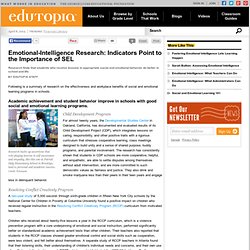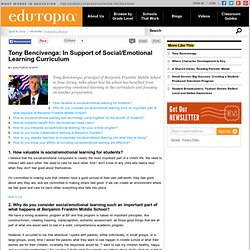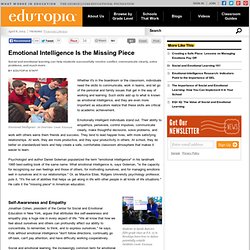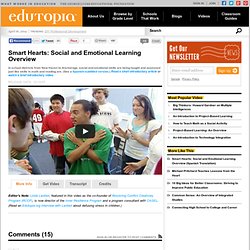

Six Seconds. Emotional Intelligence. Creating a Safe Place: Lessons on Managing Emotions Pay Off. Integrating social and emotional learning across the curriculum helps make a secure learning environment.

The social ills found in public schools -- bullying, school shootings, gang violence -- litter the media. Here's one headline, however, that didn't get much play: "Student Encourages Peer to Hand Over Unloaded Gun in School. " In October 2007, a seventh-grade student at Goldenview Middle School, in Anchorage, Alaska, was showing off the .38-caliber weapon he'd brought to school to show to a fellow student and friend.
After the friend urged him to take it to a teacher, the student did the right thing and handed it over, despite the possible punitive repercussions. End of story. This alternative headline -- or nonheadline -- was the result of social and emotional education (SEL) initiatives put in place in the Anchorage School District. Over the past decade, SEL has taken an increasingly important place in K-12 education. Emotional-Intelligence Research: Indicators Point to the Importance of SEL. Research finds that students who receive lessons in appropriate social and emotional behavior do better in school and life.

Following is a summary of research on the effectiveness and workplace benefits of social and emotional learning programs in schools. Academic achievement and student behavior improve in schools with good social and emotional learning programs. Research backs up assertions that role-playing lessons in self-awareness and empathy, like this one at Patrick Daly Elementary School in Brooklyn, lead to personal and academic success. Credit: Edutopia Child Development Program Resolving Conflict Creatively Program A two-year study of 5,000 second- through sixth-grade children in fifteen New York City schools by the National Center for Children in Poverty at Columbia University found a positive impact on children who received regular instruction in the Resolving Conflict Creatively Program (RCCP) curriculum from motivated teachers.
Responsive Classroom Seattle Development Project. Tony Bencivenga: In Support of Social/Emotional Learning Curriculum. Tony Bencivenga, principal of Benjamin Franklin Middle School in New Jersey, talks about how his school has benefited from supporting emotional learning in the curriculum and focusing on teacher preparation. 1.

How valuable is social/emotional learning for students? I believe that the social/emotional component is clearly the most important part of a child's life. We need to interact with each other. We need to care for each other. I'm committed to making sure that children have a good picture of their own self-worth, they feel good about who they are, and are committed to making others feel good. Back to top 2. Emotional Intelligence Is the Missing Piece. Social and emotional learning can help students successfully resolve conflict, communicate clearly, solve problems, and much more.

Emotional Intelligence: An Overview Credit: Edutopia Whether it's in the boardroom or the classroom, individuals need the skills to communicate, work in teams, and let go of the personal and family issues that get in the way of working and learning. Smart Hearts: Social and Emotional Learning Overview. Male Newscaster: The video was posted on MySpace by [inaudible].

This assault occurred in North Babylon, New York. The victim apparently just twelve years old. Social and Emotional Learning & Cooperative Learning. How Canada Is Closing the Achievement Gap (Education Everywhere Series) Mary Jean: Ontario is an incredibly diverse province.

And so if our goal is going to be to improve student achievement, so our children will grow into successful and happy adults, we need to deal with that diversity. And so it's not seen as a barrier, it's seen as an opportunity and a challenge. Avis: From the outset, we agreed that we had to have special interventions in place in order to bring the bottom up. The students who traditionally had not done well. Pat: So are you going to join our sports teams? Student: Yeah, I will. Pat: And what's your favorite sport?
Student: Track and field. Pat: Oh, track and field. Susan: A lot of the students that do come new to the country have a variety of needs and that may be academic, it may be social, it may be language-based. it may be family-based, it could be just survival skills. Pat: Okay, how far did you get? Student: Almost. Pat: Okay, what's happened since I read with you? Pat: Students that are new to Canada, there's a large transition.